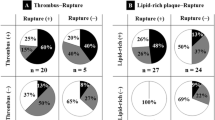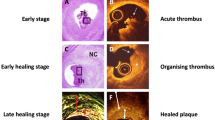Abstract
Plaque rupture (PR) and superimposed thrombosis have been shown as the most frequent underlying substrate in acute coronary syndromes (ACS). Coronary angiography is a luminogram not able to define in vivo features of the culprit plaques. The aim of the study was to use optical coherence tomography (OCT) to investigate the pathology underlying complex (CL) and non-complex angiographic lesions (NCL). We retrospectively enrolled 107 ACS patients admitted to our institution; 83 with non-ST elevation ACS (NSTE-ACS) and 24 with ST-elevation myocardial infarction. Coronary angiography was performed and culprit lesions were classified according to Ambrose criteria into NCL (n = 47) and CL (n = 60). OCT imaging was then performed to better identify plaque morphology; either PR or intact fibrous cap, the presence of superimposed thrombosis, lipid rich plaque, and thin cap fibroatheroma (TCFA). OCT analysis showed that 58 lesions (54.2 %) were classified as PR and 48 lesions (44.9 %) were associated with thrombi. Lipid rich plaques were identified in 62 lesions (57.9 %). PR, intracoronary thrombi, lipid rich plaques and TCFA were more frequent in CL compared with NCL (71.7 vs 31.9 %, 63.3 vs 21.3 %, 71.7 vs 40.4 % and 46.7 vs 21.3 % respectively), but PR with superimposed thrombus may be also detected in NCL. OCT demonstrates PR and thrombosis in the majority of ACS patients presenting with CL. However, one-third of NCL show PR by OCT, suggesting that additional intracoronary imaging by OCT may better identify the underlying mechanism of coronary instability than coronary angiography alone.


Similar content being viewed by others
References
Virmani R, Burke AP, Farb A, Kolodgie FD (2006) Pathology of the vulnerable plaque. J Am Coll Cardiol 47(8):C13–C18
Kaski JC, Chester MR, Chen L, Katritsis D (1995) Rapid angiographic progression of coronary artery disease in patients with angina pectoris. The role of complex stenosis morphology. Circulation 92:2058–2065
Dangas G, Mehran R, Wallenstein S et al (1997) Correlation of angiographic morphology and clinical presentation in unstable angina. J Am Coll Cardiol 29:519–525
Yabushita H, Bouma BE, Houser SL et al (2002) Characterization of human atherosclerosis by optical coherence tomography. Circulation 106:1640–1645
Steg PG, James SK, Atar D et al (2012) ESC Guidelines for the management of acute myocardial infarction in patients presenting with ST-segment elevation: the Task Force on the management of ST-segment elevation acute myocardial infarction of the European Society of Cardiology (ESC). Eur Heart J 33:2569–2619
Ambrose JA, Winters SL, Stern A et al (1985) Angiographic morphology and the pathogenesis of unstable angina pectoris. J Am Coll Cardiol 5:609–616
Prati F, Regar E, Mintz GS et al (2010) Expert’s OCT Review Document. Expert review document on methodology, terminology, and clinical applications of optical coherence tomography: physical principles, methodology of image acquisition, and clinical application for assessment of coronary arteries and atherosclerosis. Eur Heart J 31:401–415
Prati F, Guagliumi G, Mintz GS et al (2012) Expert review document part 2. Methodology, terminology and clinical applications of optical coherence tomography for the assessment of interventional procedures. Eur Heart J 33:2513–2522
Tearney GJ, Regar E, Akasaka T et al (2012) Consensus standards for acquistion, measurement, and reporting of intravascular optical coherence tomography studies: a report from the International Working Group for Intravascular Optical Cohenernce Tomography Standardization and Validation. J Am Coll Cardiol 59:1058–1072
Di Vito L, Yoon JK, Kato K et al (2014) Comprehensive overview of definitions for optical coherence tomography-based plaque and stent analyses. Coron Artery Dis 25:172–185
Virmani R, Kolodgie FD, Burke AP, Farb A, Schwartz SM (2000) Lessons from sudden coronary death: a comprehensive morphological classification scheme for atherosclerotic lesions. Arterioscler Thromb Vasc Biol 20:1262–1275
Mizote I, Ueda Y, Ohtani T et al (2005) Distal protection improved reperfusion and reduced left ventricular dysfunction in patients with acute myocardial infarction who had angioscopically defined ruptured plaque. Circulation 112:1001–1007
Kubo T, Imanishi T, Takarada S et al (2007) Assessment of culprit lesion morphology in acute myocardial infarction: ability of optical coherence tomography compared with intravascular ultrasound and coronary angioscopy. J Am Coll Cardiol 50:933–939
Ambrose JA, Winters SL, Arora RR et al (1986) Angiographic evolution of coronary artery morphology in unstable angina. J Am Coll Cardiol 7:472–478
Waxman S, Mittleman MA, Zarich SW et al (2003) Plaque disruption and thrombus in Ambrose’s angiographic coronary lesion types. Am J Cardiol 92:16–20
Levin DC, Fallon JT (1982) Significance of the angiographic morphology of localized coronary stenosis:histopathologic correlations. Circulation 66:316–320
Haft JI, Christou CP, Goldstein JE, Carnes RE (1995) Correlation of atherectomy specimen histology with coronary arteriographic lesion morphologic appearance in patients with unstable angina. Am Heart J 130:420–424
Uemura S, Ishigami KI, Soeda T et al (2011) Thin-cap fibroatheroma and microchannel findings in optical coherence tomography correlate with subsequent progression of coronary atheromatous plaques. Eur Heart J 33:78–85
Ino Y, Kubo T, Tanaka A et al (2011) Difference of culprit lesion morphologies between ST-segment elevation myocardial infarction and non-ST-segment elevation acute coronary syndrome an optical coherence tomography study. JACC Cardiovasc Interv 4:76–82
Hong YJ, Jeong MH, Choi YH et al (2010) Differences in intravascular ultrasound findings in culprit lesions in infarct-related arteries between ST segment elevation myocardial infarction and non-ST segment elevation myocardial infarction. J Cardiol 56(1):15–22
Jia H, Abtahian F, Aguirre AD et al (2013) In vivo diagnosis of plaque erosion and calcified nodule in patients with acute coronary syndrome by intravascular optical coherence tomography. J Am Coll Cardiol 62:1748–1758
Prati F, Uemura S, Souteyrand G et al (2013) OCT-based diagnosis and management of STEMI associated with intact fibrous cap. JACC Cardiovasc Imaging 6(3):283–287
Conflict of interest
The authors declare that they have no conflict of interest.
Author information
Authors and Affiliations
Corresponding author
Additional information
Hesham Refaat and Giampaolo Niccoli have equally contributed to the manuscript as first authors.
Electronic supplementary material
Below is the link to the electronic supplementary material.
10554_2015_632_MOESM1_ESM.doc
Supplementary Data: OCT image analysis including culprit plaque morphology and plaque characterization, is described in details in the online appendix (DOC 33 kb)
Rights and permissions
About this article
Cite this article
Refaat, H., Niccoli, G., Gramegna, M. et al. Optical coherence tomography features of angiographic complex and smooth lesions in acute coronary syndromes. Int J Cardiovasc Imaging 31, 927–934 (2015). https://doi.org/10.1007/s10554-015-0632-z
Received:
Accepted:
Published:
Issue Date:
DOI: https://doi.org/10.1007/s10554-015-0632-z




